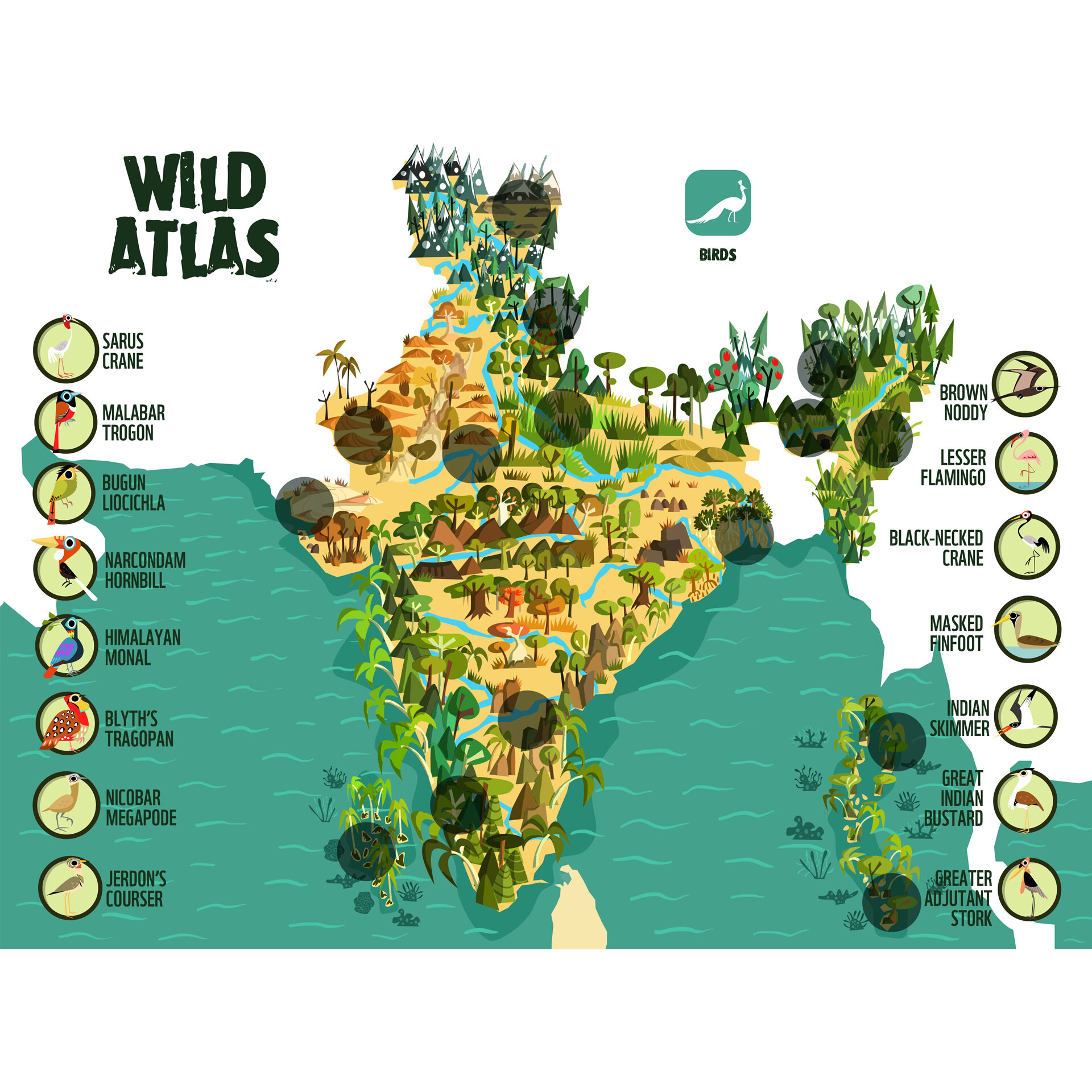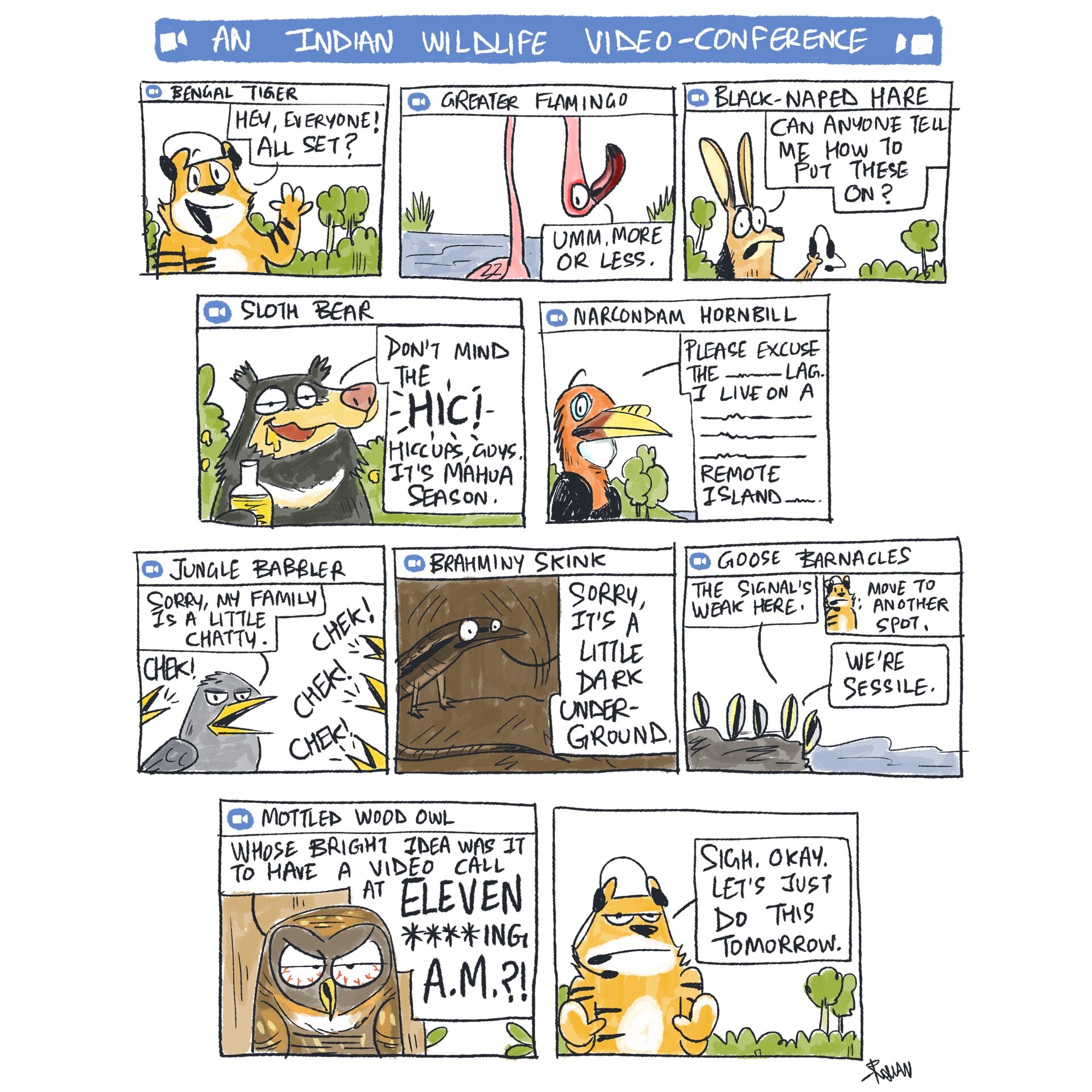Rohan Chakravarty: Saving the World, One Wildlife Cartoon at a Time
Rohan Chakravarty with Srishti. Photo: Rohit Chakravarty
Published on Roundglass Sustain - July 2020
What would a female mantis say to her mate in a sext? How would a greater flamingo, a sloth bear and a Narcondam hornbill manage a Zoom call? What tips would a signature spider have for artists? These are just some of the things Rohan Chakravarty thinks about during his day as a wildlife cartoonist.
Since 2014, Nagpur-based Chakravarty has become a full-time artist, drawing comics about wildlife and the environment in a series titled Green Humour. The cartoons, which are equal parts entertaining and educational, introduce readers to the wonders of the animal kingdom, inform them about worrisome environmental practices and policies, and encourage them to think and act responsibly. The series has helped Chakravarty become an important voice in the conservation community and beyond.
If you’re wondering just how influential his comics are, here’s some light food for thought — there’s a WhatsApp group of forest officers in India that regularly discusses Chakravarty’s work (he isn’t a part of the group, but gets updates from acquaintances) and a mascot (Bhoorsingh the barasingha) he created for Kanha National Park and Tiger Reserve features in a UPSC exam question.
Chakravarty has collaborated with state forest departments to create eye-catching mascots for various sanctuaries and reserves. Seen here are Bhoorsingh the barasingha for Kanha National Park (left) and Macha the fishing cat for the Coringa Wildlife Sanctuary (right). Photo: Madhya Pradesh Forest Department (left) Andhra Pradesh Forest Department (right)
Chakravarty’s interest in the natural world developed while growing up in Nagpur, where he had many opportunities to explore the outdoors. There was a biodiversity park with nilgai, leopards, and migratory waterfowl close to his home, and a handful of sanctuaries and national parks nearby.
Chakravarty’s curiosity was also boosted by conversations with his maternal grandfather, who came from a hunting family, though he never hunted himself. His grandfather spoke about Uttar Pradesh’s forests where he grew up, and of the hunting of chinkara and wild boar. “Wildlife was so much a part of daily conversations with him that it became a way of life to speak about and observe it without knowing what exactly we were looking at. That forms a connect, even a dormant one,” Chakravarty says.
That connectedness went from dormant to active in 2005 when Chakravarty was volunteering with Kids for Tigers, an awareness programme started by conservationist Bittu Sahgal. As a guide on nature trails and walks, Chakravarty trained himself to develop a keen eye for wildlife. One way of doing that was by interacting with the local community. “My first birdwatching walk was with two experts in Nagpur and the first bird I happened to see was a laughing dove. I find it very symbolic that I started drawing cartoons of birds after that,” he recalls. Art became a way for him to process and retain the new information he was learning. Even today, birds are his favourite creatures to draw and the subject of his most recent book Bird Business.
Despite this passion and inherent artistic skills, wildlife cartooning wasn’t Chakravarty’s first calling. He studied dentistry, and then worked as an animation designer in Bengaluru between 2011 and 2014. At this time he started moonlighting as a cartoonist, drawing comics about politics and social issues. Later he combined his love of nature and art and began developing Green Humour. “I was looking for something fresh that would give my work individuality and I found that in wildlife,” he says.
Green Humour comics don’t shy away from tackling difficult issues head-on, whether it’s the bloody cost of palm oil production or marine pollution. The work is often amplified by others, including personalities like Shashi Tharoor who retweeted the #BottleCapChallenge strip. Photo: Green Humour
He was encouraged to go into fulltime cartooning when Green Humour was picked up by GoComics, an online catalogue of syndicated strips such as Calvin and Hobbes, towards the end of 2013. He quit his job soon after and held his first solo art show in Bengaluru, featuring wildlife caricatures. It was, in Chakravarty’s words, “an unexpected success and a big turning point” in his career, providing enough financial stability to forge ahead. Soon, regular columns in newspapers like Sunday Mid-Day and The Hindu followed, widening Green Humour’s reach.
With a growing readership, Chakravarty started thinking about using his platform to achieve a larger mission, like conservation. Since he had more space in the weekend papers, he could use a longer narrative to analyse issues. “After I started doing that, the feedback was that it was bringing in an audience that wouldn’t normally engage with topics about the environment. That’s when I realised that cartooning can be a tool to take communication beyond the wildlife and science communities,” he explains.
He feels a sense of responsibility towards the environment. “I owe my muse,” he says. He is also motivated by the lack of information about environmental issues in the media. A lot escapes the public eye, according to Chakravarty. “There aren’t enough voices. If I can make my communication stand out using cartoons then it gives the discourse an edge.”
Science communication, the kind that Chakravarty is talking about, is a vital tool in the dissemination of information and fostering critical thinking. In India, science communication has evolved from dreary textbooks to innovative formats like engaging webinars, Instagram stories, podcasts and, of course, comics.
Chakravarty’s illustrated maps breathe new life into landscapes and work as engaging learning tools. Copyright: WWF India One Planet Academy
Chakravarty believes we respond to the messaging of cartoons better than other media. “I believe when the human mind sees a visual accompanied by humour, it is compelled to retain and respond to it. Humour has that punch and power,” he says. His own brand of chuckles is sometimes dark, often tongue-in-cheek, and always memorable.
When it comes to the question of what to draw, Chakravarty picks subjects based on something new and interesting he may have learned, or the quirkiness of a specific creature, or an animal that he personally relates to (like the shy pangolin that often appears in his work).
Learning takes place all the time, no matter where he is. When not hiking through forests and mountains, Chakravarty turns to his immediate surroundings to keep up his education. His routine includes completing the daily checklist challenge on the eBird app that allows users to note avian neighbours they spot. “I’ve been doing it for the last 1,200 days or so” Chakravarty gushes proudly.
Walks with Srishti and Sakshi, his dogs who are as curious about wildlife as he is, are also enlightening. They chase doves and robins, stir up butterflies and moths hidden in bushes, and dig around in Chakravarty’s backyard, unearthing skinks and lizards, and introducing him to new creatures.
The interactions with nature, he says, are valuable for more than just the knowledge they provide. “You realise you share space with so much that is special and that contributes to your life. I just learned that dragonflies prey on mosquitoes and that keeps my house malaria-free. It’s enriching to engage and observe these lifecycles and daily interactions between organisms, and between organisms and you, which is not always visible to the eye,” he says.
Green Humour combines relatable laughs with interesting facts to give us fun insights into the animal kingdom. Photo: First published in Sunday Mid-Day.
All this knowledge is combined with illustrations and current events in a way that resonates with the audience. For instance, a strip on Zoom calls —in the lockdown situation propelled by covid-19 — or about the wondrous animals Chakravarty found around his home during this period, remind readers to look around their own houses for creatures.
In addition to Green Humour strips, Chakravarty has collaborated with organisations like WWF India, the Wildlife Trust of India, Pratham Books and the Save Our Seas Foundation on illustrated maps, posters and comic books. He’s also worked with state forest departments to develop mascots for national parks, following up Kanha’s Bhoorsingh with Satpura Tiger Reserve’s Nanhi (an Indian giant squirrel), Coringa Wildlife Sanctuary’s Macha (a fishing cat) and the Great Himalayan National Park’s Jujurana (a tragopan).
His work has been read far and wide, and its impact has been felt around the world. Some folks from France wrote to Chakravarty saying they stopped buying civet coffee after a strip highlighted the unethical production processes. Women in India were inspired to seek out eco-friendly sanitary products after reading a strip about the green options available. A man in Peru who considered buying a pet monkey decided against it after reading about the pet trade threatening primates in the Amazon. “For me, sitting in India and having an impact on someone in Peru and saving the life of one monkey was a huge thing,” Chakravarty says.
Changing mindsets is one thing, but what Green Humour has also done is create a space that starts conversations. “Over the last few years, I think there’s been more engagement from readers of all kinds — from both sides of the political spectrum, from different backgrounds and vocations. Even people from the arts, who normally don’t take the trouble to engage with the sciences,” Chakravarty says. “I think I have been able to bring together a lot of people in this discourse through cartoons.”
Green Humour and its subjects may have taught readers a lot, but has Chakravarty learned anything from his muse? “I have learned that lessons from wildlife can be applied to just about any walk of life. From zero waste and low carbon aspirations to warding off a creative block, all these lessons are out in nature for our reference. And of course, upping our courtship game.”




